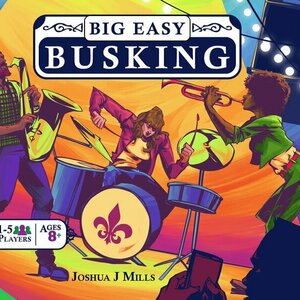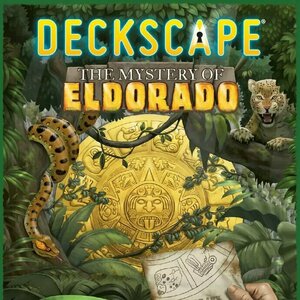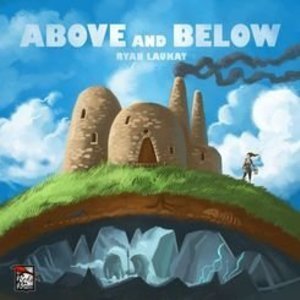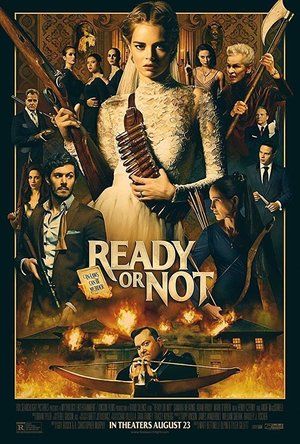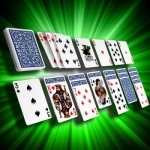
Solitaire City (Ad-Free)
Games and Entertainment
App
Play all your favorite solitaire games such as Klondike, Double Klondike, Spider, FreeCell,...
Purple Phoenix Games (2266 KP) rated Big Easy Busking in Tabletop Games
Sep 15, 2020
Big Easy Busking is a card-based area control game with a sweet sweet music theme. Players will be taking turns learning charts, playing charts, and transferring energy from the musicians to the crowd and back. The winner of Big Easy Busking is the player who can score the biggest haul in tips for the weekend to become the hottest band in town.
DISCLAIMER: We were provided a copy of this game for the purposes of this review. This is a retail copy of the game, so what you see in these photos is exactly what would be received in your box. I do not intend to cover every single rule included in the rulebook, but will describe the overall game flow and major rule set so that our readers may get a sense of how the game plays. For more in depth rules, you may purchase a copy online or from your FLGS. -T
To setup, two “streets” in New Orleans will need to be populated with song cards, both standards and learnable tunes. Crowd cards will be placed under the streets to depict certain crowds and what the moods of those crowds are. Each player will receive some starting bread (money for those not in the biz), energy for their 3-piece band of sax, trumpet, and drums, a starting set list of three tunes, and a reference card that has nothing to do with the metaphor. Decide who can play the highest note (if you are all trumpet players) and the gig may begin!
A turn is broken down into a few different parts. The first thing to be done on a turn is to finish playing the song that had been started in the previous round. Obviously you need to START playing a song to be able to finish, so the primary phase of the turn would be to either learn a song from the song offer or start playing a song from those dealt during setup. To play a song, players will choose a song card, place it under a crowd card (hopefully matching their mood: masks, hearts, beads, fleur-de-lis), gather the required energy from the musicians appropriately, and add those energy cubes to the song card.
After a song is started or learned, the player’s turn is over. On the next turn the player will finish playing the song by moving the spent energy to the crowd in full and taking $1 or moving some of the energy to the crowd and some back to their band members to be used on future songs.
The middle step in a turn (yes, I know I am explaining it out of order, but you do have to start playing a song before you can finish it) is to optionally tip your band members by trading in money for energy at a 1:1 ratio.
Once all players have used up their energy cubes or simply wish to, they will announce that they are “taking a break.” In other words, they pass for the remainder of the round. As the last player takes their break the end of round activities begin. Printed on each crowd card are two important icons: payout amounts for majority of energy and payout amounts for energy reaching the threshold. Resolving each crowd card will determine the players that hold majority or shared majority in each crowd location. For the majority holders payouts will reflect what is printed on the upper left of the crowd card. The upper right of the crowd card displays the number of energy needed upon it to meet the threshold in order to be paid the amount shown. When all crowd cards have been scored players will setup for the next night (round) per the rules. Play continues in this way over three rounds with the winner being the player at the end of the game with the most money.
Components. This is a smaller box (not exactly the same size, but think Tiny Epic), but it is packed with some really amazing bits. First off, as you can tell from the photos the art and color palette used here is simply phenomenal. I absolutely love the color scheme and the art certainly reminds me of some paintings we purchased from an artist on Jackson Square last time we were able to visit. The cards are nice, but I think I will want to sleeve them eventually as I had them in my hands the whole game. The cardboard money and mood tokens are fine, and the wooden cubes reflect the colorful nature of this little gem. All in all, exactly what I would expect from components in a Weird Giraffe Games production. Stellar (see what I did there, Carla?).
I have not really enjoyed a ton of area control games in my gaming history. So this came as a little bit of a shock as I truly loved playing this game. Even the solo rules are engaging and DIFFICULT to win. I came close though – within $1. The game is super quick as you are trying to please the crowds and their distinct moods with your best charts, but having to be mindful of not overextending your musicians lest they be too exhausted to give you the gas when you need it. THAT part resonates with me personally. Being a musician myself, I can tell you that crowds that are into a tune or a band and give them all the energy they have will be rewarded with even more from the band. I definitely give it more when the crowd digs what we’re laying down.
In any case, this is a game review, not a nostalgic trip down my musical memory lane. But then again, a little card game just brought me back wonderful memories of my band, and of visiting New Orleans, and of the joy of live music. Does Big Easy Busking completely mimic what it’s like to be a musician? Well, no, I can’t imagine how any game truly could, but it certainly shows the cyclical nature of energy being exchanged between musicians and appreciative crowds. Oh, the names of the tunes are also pretty funny on some. This all said, I super love this game and will be kicking out something in my collection to make room for it. If you are needing a smaller card game that you can bring out with musicians or non-musicians that appreciate the theme but also want to start introducing area control in a more accessible form, please do check out Big Easy Busking. Purple Phoenix Games gives it a good-for-the-soul 10 / 12. Maybe once I get into video I will do a Dan King (Game Boy Geek) serenade for Big Easy Busking as it travels into my collection.
Purple Phoenix Games (2266 KP) rated Terrible Candidates in Tabletop Games
Aug 28, 2020
Disclaimer: We were provided a copy of Terrible Candidates for the purposes of this review. The components pictured are finalized and are what come in a production copy of the game. I do not intend to rehash the entire rulebook, but rather provide an overview of the rules and general gameplay. -L
Terrible Candidates is a party game in which all players, candidates vying for the Presidency, participate in a series of public debates. At the end of the game, the player who has won the most debates is declared the new President! Setup is simple: Deal 5 Policy cards to each player, place the remaining Policy and Topic cards in the center of the table, place the Dumpster Fire of Democracy card within reach of all players to indicate the discard pile, and keep the President card off to the side.
The gameplay itself is just as simple! Select a pair of neighboring players to be the first debate Candidates. A Topic card is revealed, and the 2 Candidates select a Policy card from their hand to play in this debate. Once the Policy cards are selected, each Candidate gets 30 seconds to explain/debate their selected response to the Topic, providing as many talking points, facts (true or alternative) and other general jargon or nonsense to convince the Media (the non-Candidates for this turn) to vote for them. When both Candidates have made their debates, each member of the Media is allowed to ask one question, providing an extra chance for political shenanigans or hilarity. Once all questions have been asked, the Media votes on which Candidate they believe was the best of the pair, and that winning Candidate keeps the Topic card as their point. The game moves on to the next debate, rotating one person around the group to get a new pair of Candidates – one Candidate from the previous debate, and a new competitor. Play progresses in this manner until all players have participated in 2 debates, thus ending the round. Any players who have no Topic cards (meaning they didn’t win either of their debates in the round) is knocked out of the game, and the next round commences with the remaining players. The second round follows the steps of the first, and when all players have debated twice, the game ends. The player with the most Topic cards is declared the winner and becomes President!
I know that this game might seem like a lot, but it’s honestly not complicated. Each round works as follows: Debate, Question, Vote, and repeat until all players have done 2 debates. If there is one thing that is a must for a party game, it’s a simple set of rules and gameplay to maximize playing time, and Terrible Candidates has adhered to that policy (See what I did there?). The overall atmosphere of the game is reminiscent of CAH, but with a twist. In CAH, all players submit a card and one player is the ultimate judge for the turn, thus allowing players to cater to the personality/sense of humor of that one person. Terrible Candidates is a group effort, meaning that you have to get a majority of the votes in your favor to win the debate. Instead of focusing on one person, you have to be quick-witted and clever enough to find ways to influence all other players. That makes it feel like a more engaging game overall, since all players are involved in every step of the turn.
Obviously, this game has some political implications, but the gameplay can be whatever your group wants it to be. Playing with a group of highly political friends? Maybe it will turn into some intelligent debates and conversations throughout the night. Playing with the fam at a reunion or get-together? Go crazy, make up hilarious stories, and just have a good time. It all depends on your gaming group, and it can be whatever kind of game you want it to be – serious or silly. A caveat with this, as with CAH-esque games, is knowing your group and the kind of humor that is acceptable. Just make sure that however you decide to play, everyone involved is comfortable and having fun!
All in all, I think that Terrible Candidates is a fun and funny little game for everyone involved. As a Candidate, you put your improv skills to the test as you make ridiculous claims or present decent ideas in your 30-second time limit. As a member of the Media, you also get in on a little improv, coming up with a question to ask the Candidates, and then casting your vote for the most convincing side. This game can be so unpredictable, and that’s what helps keep it fresh, entertaining, and funny. Whether you are politically active or not, this game can result in some great times and good conversations among the group. If you’re up for it, take a chance and cast your vote for Terrible Candidates!
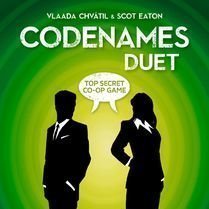
Codenames Duet
Tabletop Game
Codenames duet keeps the basic elements of codenames - give one-word clues to try to get someone to...

Halloween Supermarket Store
Games and Entertainment
App
Hey Kids! Are you crazy about Costume Parties, haunted house, trick-or-treat, or some other...
Purple Phoenix Games (2266 KP) rated Deckscape: The Mystery of Eldorado in Tabletop Games
Mar 12, 2021
Imagine yourself trapped on a jungle island after your plane crashes. Or being locked within a pyramid whilst visiting Egypt. These are the settings for the pair of games we reviewed and I really cannot and will not be going further into a lot of detail so as to avoid any spoilers as best I can.
DISCLAIMER: We were provided a copy of both The Curse of the Sphinx and The Mystery of Eldorado for the purposes of this review. These are retail copies of the games, so what you see in these photos is exactly what would be received in your boxes. I will describe the overall game flow and major rule set so that our readers may get a sense of how the game plays. For more info, you may purchase a copy online or from your FLGS. -T
To setup a game of Deckscape, open the box and take out the cards. You are now ready to play. Seriously. No rules to read. Nothing to teach others. Just read the top card and do as it says. You have now begun your adventure!
Playing the games involves players (or a solo player) encountering cards in the 60-card deck in order to solve puzzles and use items found to best finish the scenario. There are no turns in these games, and players are encouraged to discuss possibilities before committing to answers to the puzzles. Randy from Dora and the Lost City of Gold would be so happy to be figuring out “Jungle Puzzles” and “Pyramid Puzzles.”
Each card is either a puzzle or an item and each card will more than likely be encountered throughout the game. Players are trying to figure out the puzzle clues and best solve them. Incorrect guesses will result in costly errors that affect endgame scoring. Sometimes correct guesses will allow the players to erase errors or give other positive clues.
Once the players have made their way through the game solving puzzles and riddles they will consult the table at the end to see how well they scored. Usually time is of the essence, and finishing the games sooner is better than later. Once the game is over and the score tallied the game owner may gift the game away as the final result is known and replaying is kinda cheating.
Components. Okay, these games are small boxes full of large cards. There are 60 cards in each game and the cards are beautifully illustrated and laid out well. We had no problems reading anything or deciphering any part of the games, so thumbs up on components from us.
Gameplay is a little polarizing, we found. I like the flow of the game and puzzles within. My wife, however, couldn’t stand them. But she later admitted to now understanding that she just does not enjoy escape room styled board and card games. That said, these games play more like Choose Your Own Adventure games than the typical EXIT/Unlock style games, as most (if not all) cards in Deckscape require players to complete them before moving to the next card in numerical order with either a success or penalty. This can rub players the wrong way if they are used to the other style of escape room games. It was no problem for me, and I enjoyed my plays.
What I liked most about these games is that the story is easy to follow and the puzzles mostly make logical sense. A few of them stumped me, but luckily players may find helper cards to give clues to puzzles in the game. We relied on these helpers a few times, but I did not feel like we were consulting them for every puzzle. So that’s a definite positive. I also liked the thematic immersion. For a card game I felt drawn into the stories and wanted to complete them as well as I could.
What I disliked most about these games is the fact that you end up encountering every card or nearly every card. The intrigue of other escape room games I have played is wondering what was on some of those other cards. Or what did I miss on a card that I should have noticed? While you get SOME of that here, I found Deckscape to be more entry-level in difficulty. That is certainly not a bad thing for most gamers. We were expecting something different than what we played, and I think that unfortunately immediately put us off at first.
However, I played the second game solo and I liked it quite a bit. I think I mostly liked it because I didn’t have my wife around to figure out the puzzles with me and I was truly all alone. This added to my anxiety to finish well, or finish at all! I definitely cannot see myself playing these games with the full compliment of six players as I feel I would be too overwhelmed with people shouting out their guesses and trying to parse everything. But that’s just me. I prefer these with low player counts.
All in all these games are pretty good, and a decent something different from the other games in the same style. If you have yet to try Deckscape and like escape room games in general, I reccomend you give them a try. They are quick (and even quicker as your goal is finish in a short amount of time for the best scores), easy to play with zero teaching and setup time, and gives a great amount of puzzles to decipher. Purple Phoenix Games gives the Deckscape system of games an unsure-but-you-seem-confident-about-your-answer-so-let’s-just-go-with-yours 6 / 12. If you see them on the shelves pick one up and try it out. Add these to your growing collection of escape room games for show, or play them and pass them along, as I intend to do.
(Note: I usually add a messy components photo at the end of my reviews, but I don’t want to spoil anything, so I’ll just throw some cards down that won’t really ruin anything at all.)
The Marinated Meeple (1853 KP) rated Above and Below in Tabletop Games
Mar 20, 2018
Lenard (726 KP) rated Ready or Not (2019) in Movies
Sep 25, 2019

Heads Up! Kids
Games and Entertainment
App
If you love “Heads Up!” the game created by Ellen DeGeneres, played on her show and by millions...
